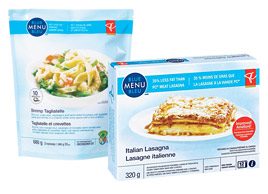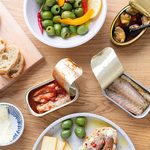The secrets behind Canada’s largest supermarket
Our writer went behind the scenes at Loblaw’s test kitchen to find out how they produce their signature President’s Choice foods’and how they keep them healthy

Source: Best Health Magazine, March/April 2010
A new product gets tested
The cavernous atrium of Loblaw’s stylish head office in Brampton, Ont., hums with activity. Employees hold impromptu meetings in the company food court while marketing staff mill around the in-house TV studio that feeds food programming to Loblaw’s network of stores and offices across Canada. Nearby, an expansive cafeteria offers a cornucopia of President’s Choice (PC) foods.
Tucked off to one side is the lively test kitchen, visible through a large glass wall. It’s a luxuriously equipped 1,400-square-foot facility, all stainless steel surfaces and cherry-wood cabinets. There’s a bank of microwaves in one corner and a spacious cooking area opposite. A dozen Loblaw chefs and product development staff buzz around, preparing for the daily tasting session, which runs from 11:30 to 1:30. The air, as always, is redolent of cooking smells. This space is considered the heart and soul of the national grocery chain, and it’s not difficult to see why.
On this early fall day in 2009, product developer Sita Kacker is presenting three new frozen-dinner recipes she’s been working on for months. The Moroccan bulgur dish and Asian-style rice will be Blue Menu meals, and the orzo with goat cheese is a President’s Choice entry. Kacker is looking for an all-important ‘endorsement’ from the team, which is the go-ahead to move from the test stage to production.
As Kacker sets out package mock-ups and tasting bowls on a table in the middle of the room, her colleagues and their boss, VP of product development Maria Charvat, drift in. A chef brings two heaping bowls of spicy basmati rice’one made in the kitchen ‘lab,’ the other from a ‘plant sample’ produced for the development phase. It’s a blind taste test.
‘We’ve enrobed each grain with sauce,’ Kacker begins, as her colleagues serve themselves small helpings of both dishes. ‘We’re the first in Canada with this technology.’
Charvat, a 57-year-old Loblaw veteran who directs the operation, lobs out questions about the packaging while the developers munch thoughtfully on the rice and try to guess which one came out of the freezer.
Product goals at Loblaw
Loblaw is Canada’s largest supermarket chain, with banners that include No Frills, Zehrs, Atlantic Superstore, Provigo, Fortinos, Real Canadian Superstore and others. As such, it has enormous influence over what Canadians eat. And because the chain’s house labels’No Name, President’s Choice and Blue Menu’account for so much shelf space, the decisions made in this test kitchen ripple out to millions of homes every day.
Twenty years ago, former Loblaw president Dave Nichol’a foodie long before the term existed’invented the President’s Choice line to market exotic recipes he’d encountered on his world travels. That label transformed Canadian diets, introducing a generation to a range of tastes that reflected the country’s growing ethnic diversity and cosmopolitanism. But Charvat, a Nichol protege, now oversees an R&D shop that faces sharply different pressures.
Apart from the usual competitive dynamic ‘Loblaw is battling giants like Walmart on one flank and indie retailers in the fast-growing local/organic food sector on the other’product developers like Kacker must be acutely aware of the health implications of the products they’re creating. Salt, sugar and fat content are key metrics. Charvat wants her team to improve the nutritional profile without compromising taste, consistency and appearance. ‘We have a huge responsibility,’ she says. ‘This sodium thing is driving me insane. We have to get it down in some products, but [at the same time] it helps preserve the food.’
Inspiration for new products
As Kacker recalls, the Asian rice recipe took shape one day as she was ‘playing around in the kitchen’ looking for something with an Eastern inflection, strong flavours and not much salt.
Like her colleagues, the 31-year-old is engaged and energetic, a member of an urban-minded, globe-trotting team of food lovers always on the prowl for interesting gastronomical experiences. She’s single, lives in Toronto, and eats out regularly because she views the city’s extraordinarily diverse restaurant scene as an important source of ideas. ‘Toronto is amazing for research,’ says Kacker, who loves yoga and sailing. ‘We’re constantly looking at whatever other restaurants and our competitors are doing, and if we find something good, that benchmarks it for us.’
Kacker was born in Montreal, but her family relocated to Oakville, Ont., when she was six. Her parents had immigrated from India, so she grew up amid interesting tastes, even though Oakville had little to offer at the time by way of exotic cuisine. She studied nutrition at the University of Guelph, then stuck around to do an M.Sc., dividing her academic attention between food science and cooking courses, a personal passion. ‘It was like putting the two worlds together.’
Graduate degree in hand, Kacker found her first food industry job at a Toronto fine-foods retailer and then joined Loblaw in 2005. She began in the boxed meats category, moved to the ‘meal replacement’ segment (prepared foods like salads and rotisserie chicken), then transferred to frozen foods’first ice cream and now dinners. (Anyone who has eaten Loblaw’s New York Sicilian Pizza and its Best Ever Lasagna has sampled Kacker’s handiwork.)
A goal of healthier’and tastier’eating
Just a few years ago, Loblaw was in financial crisis. Walmart, new in the supermarket sector, was soaking up Loblaw’s market share, and share prices plummeted. When Galen Weston Jr. stepped in as CEO, he moved to right the ailing chain, shedding head-office staff and making a personal televised pitch to consumers to cut their use of plastic bags.
Early in 2008, Weston asked Charvat’s 15-member team to ‘update’ 1,000 house-brand items‘a massive culinary reno job. Charvat is a kind of den mother to the product developers. She lives near a large fresh-food market in downtown Toronto, and describes herself as someone who loves to cook with very fresh ingredients”eggs that were laid yesterday,’ as she puts it.
Charvat represents the institutional memory of Nichol’s obsession with novel eating experiences. As a result, she knows she has to motivate her team to innovate. She sends developers to cooking courses at such distinguished venues as The Culinary Institute of America. Sometimes, prominent chefs are invited to the test kitchen to show their stuff. ‘You’re trying to get the developers to push the envelope,’ Charvat muses. ”’How can we make it better?’ The pressure is enormous.’
The evolution of new products
For her part, Kacker works on upgrading 60 to 70 house-brand products at any given time, scouting for new ideas, better tastes and healthier ingredients. Last spring, she turned her attention to frozen bagged entrees that serve two to four. Charvat wanted vegetarian entrees with a health aspect focusing on sodium, fibre and fat. She also wanted each package to have four servings of vegetables.
‘The ideas can come from anywhere,’ Kacker observes. She decided to look at alternative grains and pastas, such as orzo, quinoa, bulgur, couscous and basmati rice. Whittling down the ingredients list, Kacker wanted the dishes to be ‘ethnically inspired.’ For the bulgur dish, she opted for a Middle Eastern style. As for the orzo, Kacker thought she’d mix in goat cheese, mainly because she loves the stuff.
After Loblaw’s chefs work up the recipes, the product developers approach the food manufacturers that produce the company’s house-label goods. For this project, Kacker had identified a packaging angle. Typically with frozen meals in bags, the sauce doesn’t get distributed evenly. So for the orzo, rice and bulgur dishes, Kacker and Charvat chose a French firm’whose name they won’t reveal’with a novel manufacturing technique. It uses liquid nitrogen (which is harmless to humans) to bind the flavouring to each grain, pasta or vegetable morsel. While other companies, such as Knorr, may use similar techniques, Loblaw wanted to be the first with a vegetarian dish using the binding technique.
Last April, Kacker flew to France to work with the firm’s chefs on how to translate Loblaw’s lab recipes into mass-produced versions, according to specific nutritional parameters (the data that will eventually be on the package’s nutrition label).
What product developers do
It’s a typical assignment for Loblaw’s product developers. Charvat points out that the specialized job entails extensive travel, often on short notice, because Loblaw works with food processing companies all over the world. The product developers serve as go-betweens, ensuring suppliers don’t stray from the original assignment. Says Charvat, ‘They need lots of energy for this work, and balance at home, because the travel can be very disruptive.’
After the week in France, Kacker flew home, leaving Loblaw’s partner firm with instructions to create a ‘trial’ version of the three dishes. Loblaw’s approach is to have its vendors ramp up and do a complete run of products in the development stage, although these will never be sold to consumers. The point is to see how the product cooks and tastes. It’s a classic trial-and-error process, Kacker says. Once in a while, the vendor nails it the first time”if you’re lucky”but typically, the two sides have to go back and forth to hone the mass-scale version.
Back in the test kitchen on that autumn morning, Charvat and the product developers have sampled both the bulgur dish and the Asian rice. Both will be Blue Menu products: the basmati because it has very little fat (less than three grams per serving), the bulgur because it’s high in fibre (10 grams).
An assistant product developer then lays out two bowls of the orzo meal. They smell delicious. As the product developers taste it and compare it to the first version they tried, Kacker explains to the group that she added some balsamic vinegar and a bit of Dijon mustard to make the flavour more vivid.
Well before a product has reached this stage, the company’s marketing and merchandising teams have developed a business case for each, identifying competing goods, supply chains and price points. But nothing moves forward unless it has passed muster with Charvat and her team.
A primary role of Charvat’s group is to stand around that table for two hours every day, eating critically. It’s both an art and a science. ‘You train yourself,’ says Kacker. ‘Everyone can taste. The issue is communicating what you’re tasting.’ With the samples, they taste without swallowing, to avoid weight gain. ‘We actually spit it out.’
On the day her three vegetarian dishes are up to bat, one of Kacker’s colleagues presents a version of a focaccia bread originally made by Ace Bakery in Toronto. Another is demonstrating a kettle-cooked corn chip with a hardy consistency due to a new grinding process. Kacker nibbles on one: ‘I just love the bite of these.’ Next up is a hummus. Charvat dips in a corn chip and pops it in her mouth. She opens her eyes very wide in a look that signals she’s not impressed.
Charvat’s group does its professional due diligence on each new item, but head-office personnel are encouraged to do ‘home evaluations”testing products in the trial stage. (Loblaw does not do consumer sampling of its products.) For each one, 50 to 60 employees will receive a plant sample in preliminary packaging and are asked to rate variables including spiciness and texture, as well as packaging information, such as the directions. ‘You’re trying to validate those cooking instructions,’ says Kacker.
The new vegetarian meals pass muster
When she received the results for the vegetarian meals, the numbers looked great. On a scale of one to five, the second pass of the orzo dish got average ratings of 4.45, 4.27 and 3.91 on quality, overall expectation and price, respectively. But Kacker pays particular attention to one question: ‘Would you purchase this product again?’ The report notes that 100 percent of the respondents answered yes. ‘If you get over 75 percent, you’re golden,’ Kacker says.
Kacker can now ask Loblaw’s business teams to commission food photography, finalize the packaging, confirm the nutritional analysis and scope out the marketing strategy.
Early in December, Kacker was on hand at the vendor’s factory in France. As the plant churned out packages of bulgur, rice and orzo dishes for about six or seven hours, Kacker and her colleague randomly snatched boxes off the line to weigh the contents and ensure each had the quantity of vegetables promised on the package. Then came the so-called ‘sensory endorsement”an on-site confirmation that these meals had the same taste and consistency as those endorsed in September at Loblaw’s test kitchen.
With that last confirmation, Kacker, who is already working on the next wave of products, gave the green light to go into full production mode with an eye to filling a shipping container with tens of thousands of units, to supply Loblaw’s supermarkets across Canada.
A month later, Kacker did what she often does with products she’s shepherded through: picked one up at her local store. ‘It’s always fun to go back and buy your product. It’s something you worked on. You want to believe in it.’
This article was originally titled "The Trendmakers," in the March/April 2010 issue of Best Health. Subscribe today to get the full Best Health experience’and never miss an issue!’and make sure to check out what’s new in the latest issue of Best Health.




